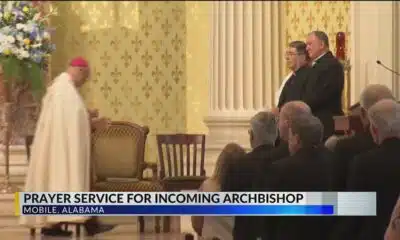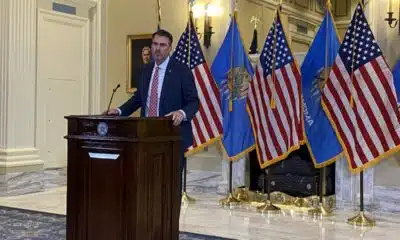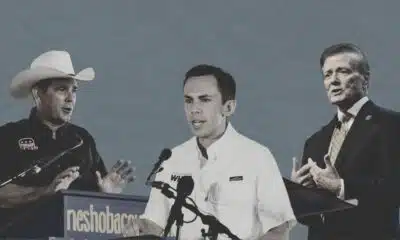News from the South - Alabama News Feed
NOAA predicts above-average hurricane activity this year
by Amy Green, Inside Climate News, Alabama Reflector
May 25, 2025
This article originally appeared on Inside Climate News, a nonprofit, non-partisan news organization that covers climate, energy and the environment. Sign up for their newsletter here.
Forecasters at the National Oceanic and Atmospheric Administration expect above-average hurricane activity this season.
The federal agency, in its annual outlook released Thursday, predicted 13 to 19 named storms, including six to 10 hurricanes. Of those, it expects three to five major hurricanes of category 3, 4 or 5 strength, packing winds of 111 mph or greater.
The agency said there was a 60 percent chance of an above-normal season, a 30 percent chance of a near-normal season and a 10 percent chance of a below-normal season. The forecast represents an estimate of activity, not number of landfalls.
GET THE MORNING HEADLINES.
The average season features 14 named storms, including seven hurricanes and three major hurricanes, according to NOAA. The season begins June 1 and ends Nov. 30.
“We’re ready here at NOAA,” said Ken Graham, director of the National Weather Service, during a news briefing held in Gretna, Louisiana, to mark 20 years since Hurricane Katrina. “Are you?”
NOAA based its forecast on a confluence of factors, including warmer than average ocean temperatures, potentially weak wind shear and the possibility of higher activity from the West African Monsoon, a primary starting point for Atlantic hurricanes. Warmer oceans fuel storms with more energy, while weaker winds allow them to develop without disruption.
Forecasters at Colorado State University also anticipate an above-average season, with 17 named storms—including nine hurricanes, four of them major. The forecasters predicted activity would be about 125 percent of that during an average season between 1991 and 2020.
By comparison, activity in 2024 was about 130 percent of an average season’s during that time. The 2024 season will be best-remembered for hurricanes Helene and Milton, which together caused more than 250 fatalities and $120 billion in damage across the Southeast.
The Colorado State University forecasters said this season there is a 51 percent chance of a major hurricane striking the U.S., with a 26 percent chance of one of the storms making landfall along the East Coast and 33 percent chance along the Gulf Coast. They predict a 56 percent chance of a major hurricane tracking through the Caribbean.
The season arrives amid widespread uncertainty over the role the federal government will play in disaster response and recovery, as the Trump administration fires employees, freezes funding and dismantles agencies. NOAA and the Federal Emergency Management Agency are among the targets.
“Uncertainty is not great,” said Phil Klotzbach, a senior research scientist at Colorado State University’s Department of Atmospheric Science. “It just adds another layer of stress. That isn’t great when people are trying to prepare for hurricane season.”
As much as 30 percent of the workforce at NOAA’s National Weather Service has been eliminated, said Rick Spinrad, a former NOAA administrator under the Biden administration. He worried NOAA may struggle to maintain its Hurricane Hunter flights, which he said account for a 15 percent improvement in track and intensity forecasting.
“If you lose that capacity to predict the track, you could either unnecessarily evacuate tens or hundreds of thousands of people, or evacuate the wrong people or not evacuate people who should be evacuated,” he said. “So we are putting lives and property in significant danger with the degradation of the forecast capability.”
No changes to the flights have been proposed, said Michael “Mac” McAlister, who has flown with the Hurricane Hunters for 10 years. This will be the 50th season for one of the two aircraft involved in the program, a WP-3D Orion named Kermit. The other plane is called Miss Piggy.
“There are hardly any 50-year-old pieces of this aircraft left,” McAlister said, referring to Kermit. “The wings get chopped off every five years. In my opinion these are two of the greatest national assets, because of the data they provide.”
No one from the National Hurricane Center, a division of the National Weather Service, attended this year’s National Hurricane Conference in New Orleans, said Craig Fugate, a former FEMA administrator under the Obama administration and former director of the Florida Division of Emergency Management.
Normally the National Hurricane Center would brief state and local emergency managers at the conference on new forecasting methods, to help the managers improve communications with the public about, say, when evacuations are necessary. The training is important because there can be high turnover among emergency managers, he said.
“I’m just not aware of any other time that the hurricane center staff wasn’t at that conference,” Fugate said.
NOAA declined to comment on the conference but said Thursday its forecasts would be no less accurate. For instance, the federal agency said the model used to predict hurricanes would undergo an upgrade that would improve track and intensity forecasts by as much as 5 percent.
“We are fully staffed at the Hurricane Center, and we are definitely ready to go,” said Laura Grimm, acting NOAA administrator. “We are really making this a top priority for the administration.”
Kim Doster, the agency’s communications director, added in a statement, “in the near term, NWS has updated the service level standards for its weather forecast offices to manage impacts due to shifting personnel resources. These revised standards reflect the transformation and prioritization of mission-essential operations, while supporting the balance of the operational workload for its workforce. NWS continues to ensure a continuity of service for mission-critical functions.”
Meanwhile, FEMA is in turmoil, with President Donald Trump suggesting he might eliminate the federal agency. Cameron Hamilton, acting head of FEMA, was ousted earlier this month after testifying before a congressional subcommittee that elimination would not be “in the best interest of the American people.” His dismissal coincided with National Hurricane Preparedness Week, declared by Trump in a proclamation in which the president said he remained “steadfastly committed to supporting hurricane recovery efforts and ensuring that Federal resources and tax dollars are allocated to American citizens in need.”
But during Trump’s first week in office he appointed a task force to review FEMA’s ability to respond to disasters. And in March he signed an executive order asserting that federal policy must “recognize that preparedness is most effectively owned and managed at the State, local, and even individual levels.” The order called on state and local governments and individuals to “play a more active and significant role in national resilience and preparedness.”
In April the administration denied a request for assistance from Arkansas Gov. Sarah Huckabee Sanders, a Republican, after tornadoes ripped through several counties there. The administration approved the request in May.
Nonetheless, FEMA told Inside Climate News in a statement, before Hamilton was fired, that its response to disasters would not be diminished.
“Unlike the previous administration’s unprepared, disgraceful and inadequate response to natural disasters like Hurricane Helene, the Trump administration is committed to ensuring Americans affected by emergencies will get the help they need in a quick and efficient manner,” the statement reads. “All operational and readiness requirements will continue to be managed without interruption in close coordination with local and state officials ahead of the 2025 Hurricane Season. Emergency management is best when led by local and state authorities.”
In Florida, Gov. Ron DeSantis welcomed the prospect of more state leadership in disaster response. During an April event in Kissimmee he said he believed the Trump administration would send block-grant funding to states, which could manage the calamities more efficiently.
“We’re not going to be left in the cold. But I can tell you that the FEMA bureaucracy is an impediment to disaster recovery,” said DeSantis, who ran against Trump in the 2024 Republican primary. “We’re nimble. We’re quick. We adjust. So empower the states. Give us the resources, and we don’t necessarily need the federal government to be involved at all.”
But state and local governments already lead the response to disasters, Fugate notes. Governors request federal help only when the scope of the crisis exceeds the state’s capabilities, with the federal government providing little more than funding.
He said it was too soon to guess how all of the developments may affect hurricane season.
Even more cuts could be coming
Trump’s budget request, released earlier this month, would slash more than $1.3 billion from NOAA and $646 million from FEMA. Congress must approve the proposal.
An earlier leaked draft, obtained by Inside Climate News, would abolish NOAA’s research office, called Oceanic and Atmospheric Research or NOAA Research. The office is charged with providing unbiased science to, among other things, improve forecasts and enhance warnings ahead of disasters. The draft included $171 million for the office, down from $485 million in 2024. The few programs that remain, including research into severe storms, would be moved primarily to the National Weather Service and National Ocean Service.
The Trump administration’s 2026 budget passback, as the draft was called, included “significant reductions to education, grants, research, and climate-related programs within NOAA,” according to the document. “Passback levels support a leaner NOAA that focuses on core operational needs, eliminates unnecessary layers of bureaucracy, terminates nonessential grant programs and ends activities that do not warrant a Federal role.”
Project 2025, the conservative strategy for remaking the federal government, calls for NOAA to be taken apart, with many functions eliminated, privatized or moved to other agencies or state and local governments. The document suggests reforming FEMA to shift much of its spending on preparedness and response to state and local governments.
“We’re just providing as accurate information as we can,” said Andy Hazelton, a National Weather Service scientist who was let go earlier this year. “Hopefully we can get back to that, but it’s been a very, very tough environment for the last few months.”
In central Florida, all of the uncertainty has left Alan Harris, the emergency manager in Seminole County, grappling with how to prepare for hurricane season. Seminole is a suburban county north of Orlando that is spliced through by the St. Johns River, Florida’s longest. The county has experienced flooding during several recent hurricanes, including Ian in 2022 and Milton in 2024.
The agency depends on forecasts from the National Weather Service and National Hurricane Center and assistance from FEMA after a storm has passed. It had applied for a grant for a new generator for a special needs shelter under the federal Building Resilient Infrastructure and Communities program, which Trump signed into law in 2020. But the Trump administration ended the program recently.
“We at the local level are going to make sure that our residents are taken care of regardless of what happens at the federal or state level,” Harris said. “We will need help. We just don’t know where that help is going to come from. But I have 100 percent confidence that there will be help whether it’s through mutual aid agreements or it’s from other states or our own state. We’re going to make sure our residents are taken care of.”
YOU MAKE OUR WORK POSSIBLE.
Alabama Reflector is part of States Newsroom, a nonprofit news network supported by grants and a coalition of donors as a 501c(3) public charity. Alabama Reflector maintains editorial independence. Contact Editor Brian Lyman for questions: info@alabamareflector.com.
The post NOAA predicts above-average hurricane activity this year appeared first on alabamareflector.com
Note: The following A.I. based commentary is not part of the original article, reproduced above, but is offered in the hopes that it will promote greater media literacy and critical thinking, by making any potential bias more visible to the reader –Staff Editor.
Political Bias Rating: Center-Left
This article primarily reports on the forecast for an active hurricane season while highlighting concerns over federal budget cuts to NOAA and FEMA under the Trump administration. The inclusion of critical commentary on staffing cuts, funding reductions, and disruptions in disaster preparedness reflects a perspective that is wary of the current administration’s approach to federal disaster management. Although it presents factual information about forecasts and statements from officials on all sides, the emphasis on the potential negative impacts of budget cuts and administrative changes suggests a subtle lean toward the Center-Left, concerned with maintaining robust federal oversight and support for climate-related and disaster response agencies.
News from the South - Alabama News Feed
Mobile parishioners thank Archbishop Rodi ahead of new archbishop’s installation
SUMMARY: The Archdiocese of Mobile held a prayer vigil to honor Archbishop Thomas Rodi as he prepares to retire after 17 years of service. Local Catholics expressed gratitude for Rodi’s leadership and welcomed incoming Archbishop Mark S. Rivituso with optimism. Parishioners praised Rodi’s dedication and kindness, wishing him well in retirement, while expressing excitement for Rivituso’s future role. Archbishop Rodi described Mobile as a faith-filled, supportive community, confident Rivituso will thrive there. The installation of Archbishop Rivituso is scheduled for Wednesday at the Cathedral of the Immaculate Conception in Downtown Mobile.
A prayer vigil was held Tuesday evening for Mobile’s next archbishop, the Most Rev. Mark S. Rivituso. Archbishop Thomas Rodi was in attendance, and parishioners expressed their gratitude for the work he’s done in the last 17 years.
News from the South - Alabama News Feed
Study: Alabama’s moral turpitude laws contribute to racial disenfranchisement disparities
by Ralph Chapoco, Alabama Reflector
September 2, 2025
BIRMINGHAM — Robert Cheeks cast a ballot in Birmingham’s municipal elections last week and received a standing ovation from poll workers.
It was the first time that Cheeks, 82, had voted. Until the most recent election, his criminal history barred him from participating in the electoral process.
“I had never voted before and it was always my wish to vote,” he said after he cast his ballot. “I had the opportunity, encouraged, to vote, and I said I want to exercise my right as a citizen in the state, and I wanted to vote because I had never voted before.”
GET THE MORNING HEADLINES.
For Black Alabamians like Cheeks who have criminal convictions, getting the right to vote restored can be difficult, according to a new report from Return My Vote, an organization that assists people with criminal convictions with regaining their right to vote.
The study, “Alabama’s Moral Turpitude Law Disproportionately Strips Black Citizens of Their Voting Rights,” found that Black Alabamians were four times more likely to lose their right to vote than white Alabamians.
“The most basic, and most important, finding is that overall that people who were dropped from the voter file or denied registration due to felony conviction, a majority of them were Black,” said Richard Fording, a professor of political science at the University of Alabama and a co-author of the study. “Not a large majority, but over 50% of them were Black. It was about twice the percentage of the general population that is Black in Alabama, and so, of course that is alarming.”
Alabama laws generally deny the vote to those convicted of crimes of moral turpitude, a broad phrase that was subject to interpretation until the state began listing specific crimes under it in 2017. While some states automatically restore voting rights after a person completes a sentence, Alabama has a more complicated process.
While only a handful of crimes can permanently cost a person their vote, some require pardons from the Alabama Board of Pardons and Paroles. Others require a Certificate of Eligibility to Register to Vote once they have completed their sentence, which includes payment of any fines, fees and restitution.
The authors of the study studied 25,000 people removed from the voter rolls or disqualified from voting between 2017 and 2020 due to criminal conviction. Study authors were able to review the information only after the Campaign Legal Center had obtained the records after a federal judge had required the Alabama Secretary of State’s Office to release it.
Disparities
According to the study, Black men were disenfranchised at a rate of 22.4 citizens per 1,000 men of voting age. That is almost four times the rate for their white counterparts, whose rate was 6.7 citizens per 1,000.
The rate for disenfranchising Black women was 3.9 citizens per 1,000, almost twice the rate of white women, whose disenfranchisement rate was 2.1 citizens per 1,000 white women.
Counties with significant Black populations had some of the highest Black disenfranchisement rates and largest racial disparities in disenfranchisement. Seven of the 10 counties with the highest rates of disenfranchised voters are within the Black Belt. The rate for disenfranchising Black men in Monroe, more than 40% Black, was 40.6, compared to 8 per 1,000 for white men. In Perry County, with a Black population of 70%, the rate was 30 citizens per 1,000 Black men of voting age. The rate was 11.4 for white men, almost three times lower.
The disparities are less pronounced for women in the same counties, but they still exist. In Monroe County, Black women are disenfranchised at a rate of 5.6 citizens per 1,000 Black women who are at least 18 years old. For white women in that county, the rate is 2.4, less than half.
Study authors stated in the report that even though there is some uncertainty with the information because of problems collecting data, after reviewing the Uniform Crime Report data obtained from the FBI website, the findings indicated that more Blacks are disenfranchised than whites even when criminal convictions are considered.
“Nevertheless, the most important takeaway is that the disproportionate percentage of arrests for disqualifying offenses by Blacks in Alabama (42%) cannot fully account for the significantly higher percentage of Blacks disenfranchised by the state (52%) during 2017-2021,” the report states.
The study also found that Blacks have a more difficult time regaining their right to vote after they are removed from the voter rolls after getting convicted of a crime.
Authors also investigated the number of people who were removed from the voter rolls from 2017-2021 who had regained their voting rights and registered to vote once again by 2024. According to the study, 1,034 people who are Black reregistered to vote after they completed their sentence, about 8.3% of the total. That is less than the almost 13% of whites registered to vote after a criminal conviction.
The study suggested that the disparities could stem from disparities in the application of Alabama’s felony disenfranchisement law and uneven methods of voter file maintenance in the state.
“Regardless of the reason, the significant variation in county-level disenfranchisement rates calls for further investigation into how Alabama’s felony disenfranchisement law is being implemented at the local level,” the report said. “This is especially important given federal law that requires uniform implementation of state election laws across counties.”
‘It means so much’
Cheeks spent almost 40 years in the custody of the Alabama Department of Corrections after receiving a mandatory life sentence in 1985 for a robbery. Cheeks had prior convictions of forgery and assault, leading to the sentence but no one was physically injured. Cheeks spent 30 years working in the kitchen at Donaldson Correctional Facility in Bessemer without pay, according to Alabama Appleseed.
Cheeks was released in July 2022. His criminal convictions required him to obtain a Certificate of Eligibility to Register to Vote, which he applied for and received from the Alabama Bureau of Pardons and Paroles. Cheeks, with the help of supporters, then registered to vote with the Board of Registrars in Jefferson County and acquired full citizenship once again after spending nearly four decades incarcerated in Alabama’s prisons.
“It is more important now than it would have been in the first place,” Cheeks said of voting. “I have been so anxious over the years to vote. I have been hearing so much about voting, and I wanted to express my opportunity for the right to vote. It is granted to American citizens by right, and I wanted to do that. I am so thankful. It is a blessing, and it means so much.”
Independent Journalism for All
As a nonprofit newsroom, our articles are free for everyone to access. Readers like you make that possible. Can you help sustain our watchdog reporting today?
Alabama Reflector is part of States Newsroom, a nonprofit news network supported by grants and a coalition of donors as a 501c(3) public charity. Alabama Reflector maintains editorial independence. Contact Editor Brian Lyman for questions: info@alabamareflector.com.
The post Study: Alabama’s moral turpitude laws contribute to racial disenfranchisement disparities appeared first on alabamareflector.com
Note: The following A.I. based commentary is not part of the original article, reproduced above, but is offered in the hopes that it will promote greater media literacy and critical thinking, by making any potential bias more visible to the reader –Staff Editor.
Political Bias Rating: Center-Left
This content highlights issues of racial disparities and systemic barriers related to felony disenfranchisement in Alabama, focusing on the disproportionate impact on Black citizens. It emphasizes social justice concerns and critiques existing laws and their implementation, which aligns with a Center-Left perspective that advocates for voting rights expansion and racial equity. The tone is factual and empathetic, without overt partisan language, but the focus on structural inequalities and reform suggests a leaning toward progressive policy viewpoints.
News from the South - Alabama News Feed
Monroe County Football Coach speaks out, calls for more support for team
SUMMARY: Monroe County High School football coach Robert Wilkerson is urging more support from parents, alumni, and the community. Since starting in April, Wilkerson has faced challenges such as low game attendance, limited adult volunteers for filming and chain crew, and a lack of trainers. He publicly expressed concerns on Facebook, emphasizing the need for people to attend games and boost team morale. Wilkerson highlights issues like outdated training equipment and lack of pride in the school. He calls for increased community involvement through their “adopt a tiger” program and donations via an Amazon wish list to improve the team’s resources.
Head Coach Robert Wilkerson says building the team starts with more people attending games and helping the young players.
-
Mississippi Today3 days ago
DEI, campus culture wars spark early battle between likely GOP rivals for governor in Mississippi
-
News from the South - North Carolina News Feed6 days ago
Parasocial party: Why people are excited for the Taylor Swift, Travis Kelce engagement
-
News from the South - Louisiana News Feed6 days ago
K+20: Katrina alters local health care landscape, though underlying ills still the same
-
Our Mississippi Home7 days ago
The Great Backyard Recovery – Helping Birds After the Storm
-
Local News6 days ago
Police say Minneapolis church shooter was filled with hatred and admired mass killers
-
The Center Square7 days ago
U-M Health ends transgender treatment for minors | Michigan
-
News from the South - Alabama News Feed7 days ago
Katrina displaced 1.5M across the South, only 61% returned to New Orleans | Louisiana
-
Local News Video5 days ago
08/29 Ryan's “Wet End to the Week” Friday Forecast









































